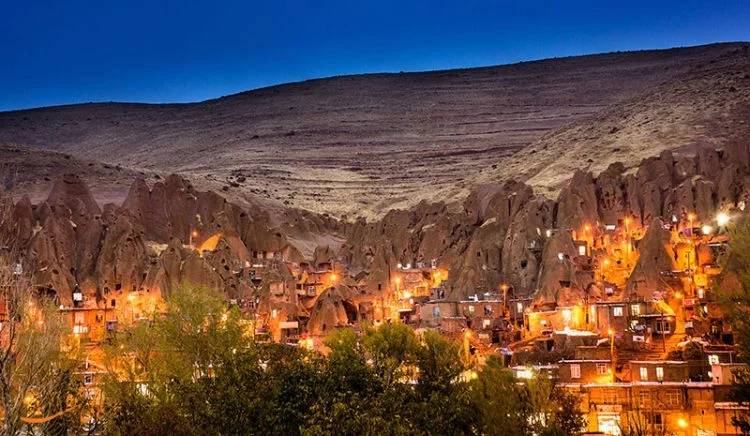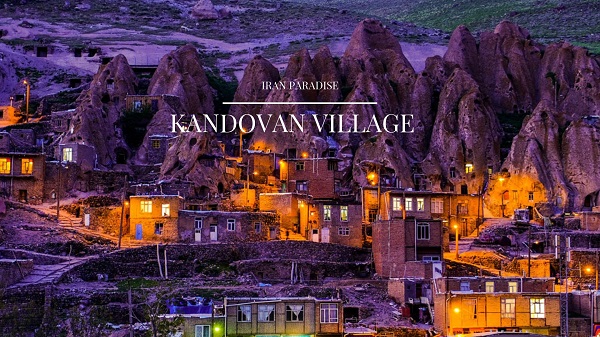Kandovan, situated 50 kilometers southwest of Tabriz, stands out as one of the most captivating villages in Iran. Nestled 18 kilometers south of Osku, this village adorns the lush slopes of Sultan Daghi. As per the 2006 general population and housing census, Kandovan is home to 137 families and 601 individuals engaged in agriculture, animal husbandry, and handicrafts. What truly sets Kandovan apart is the remarkable man-made cave dwellings nestled within conical and pyramidal beehive-shaped rock formations. The residents of Kandovan have ingeniously carved out their homes, livestock shelters, storage facilities, and workshops within the rock itself.
Kandovan village stands out as a renowned and remarkable natural and cultural gem in Iran’s East Azarbaijan province. It holds the distinction of being the sole “inhabited rocky village” in the world. While there exist two other similar villages in Cappadocia, Turkey, and Dakota, America, the key difference lies in their deserted status.
With a rich history spanning over a millennium, the historic Kandovan village is nestled in Osku county, 70 kilometers away from Tabriz. The distinctive beehive or sugarloaf-shaped dwellings of this village are nestled deep within the mountains, formed entirely by natural volcanic phenomena, devoid of human intervention.
One of the most remarkable aspects of Kandovan is its geological wonder. The village is carved into the volcanic rock formations that define the region. Over millions of years, volcanic ash and debris from the extinct Mount Sahand have solidified into tuff, a malleable rock easily excavated. Leveraging this natural marvel, the inhabitants of Kandovan have meticulously carved their homes directly into the rock, crafting a landscape that is both unique and surreal.
Kandovan is far from being a mere historical artifact; it is a thriving village where age-old traditions are still practiced. The residents have painstakingly upheld their distinctive lifestyle and the village’s unique architecture. They pass down the craft of rock carving from one generation to the next, ensuring that these ancient skills endure the test of time.

The history of Kandovan is just as fascinating as its distinctive architecture. The village’s origins are thought to date back over 700 years, and some accounts even suggest an even older timeline. Its inception is intertwined with the migration of Turkic tribes to the region, marking centuries of cultural exchange and adaptation.
While the village likely took root in the late 13th or 14th century AD, some archaeological research even speculates that the dwellings may trace back as far as 7,000 years. Legend has it that the “Hileh Var” tribe sought refuge in the Kandovan cliffs during the Mongol invasions, capitalizing on the natural insulation of the dwellings to keep cool in summer and warm in winter. These early settlers are believed to have chosen to make this refuge a permanent home, thereby transforming the area into a thriving village that remains inhabited to this day.
The cliffside features distinctive hive-shaped cells, also known as ‘Karan’. Each chamber within the cliff dwellings is hewn from rock, with ancient inhabitants initially carving out windows and later adorning them with vibrant glass decorations.

The concept of rock architecture represents a testament to humanity’s interaction with nature and the utilization of naturally occurring rock formations. While conventional architecture relies on materials like gypsum, lime, and clay as the primary building components, rock architecture involves the carving of desired spaces directly into the rock mass itself.
The dwellings in Kandovan transcend mere housing; they stand as enduring architectural marvels passed down through generations. These homes, carved into the rock, often encompass multiple stories, several rooms, and even kitchens. The rock’s natural insulation ensures that the interiors remain cool during the sweltering summers and warm amidst the biting winters, resulting in remarkably energy-efficient homes.
Notably, some of the houses in Kandovan have been repurposed into inviting guesthouses, offering visitors the opportunity to immerse themselves in the remarkable lifestyle of the villagers. A stay in one of these homes is akin to stepping back in time while relishing modern conveniences.
The interactions of the Sahand Mountains have given rise to a breathtaking and refreshing vista in one of the most picturesque regions of Iran, resembling something out of a dream. For millennia, molten lava has flowed from the craters of the Sahand volcano and adjacent volcanic mountains. As these lava streams accumulated over the centuries, they gradually formed a rocky crust. The result is a multitude of diverse, paired, singular, conical, and spindle-shaped formations, crafting one of Iran’s most splendid natural landscapes.
Over thousands of years, volcanic molten masses and lava have been molded and sculpted by winds and storms. Consequently, the softer parts of these formations erode away, leaving behind the harder, enduring segments—creating a spectacle akin to a natural miracle. The relentless forces of wind and rain, particularly at the borders near the village’s entrance, have led to substantial erosion. In contrast, at the eastern and western extremities of the village, the formations persist at greater heights and in better condition, owing to the presence of elevated hills.
Kandovan encompasses essential community facilities such as a mosque, public Persian Hammam (bathhouse), school, and a mill. The houses predominantly feature two floors, with some even boasting three or four levels.
Although Kandavan village in Tabriz is inhabited peacefully all year round, the best time to travel to this area is from April to November. Winter may be accompanied with snow fall, making it difficult to reach or to explore the village.